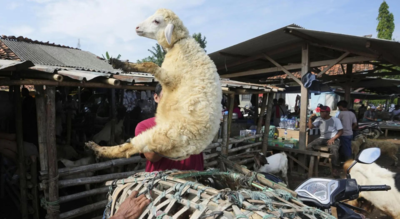ARTICLE AD BOX

Eid Al Adha Sheep Prices Vary Sharply Across Arab World Amid Economic Strain/ Image: (AP/ Achmad Ibrahim)
As Eid Al Adha approaches, Muslims across the Arab world are facing sharply rising sheep prices, a challenge that, according to Gulf News, is prompting many families to scale back, share animals, or choose symbolic alternatives.
While the religious significance of the sacrifice remains unchanged, the financial strain is making the tradition increasingly difficult for many to uphold.
Cheapest in Sudan and Yemen
In Sudan, sacrificial sheep remain among the most affordable in the Arab world, averaging $220. This is despite the country’s ongoing conflict and economic collapse. Sudan has over 40 million sheep, the highest number in the region, and its strong pastoral traditions and abundant livestock help keep prices relatively stable.In Yemen, sheep also cost between $200 and $220, making them accessible for more families. However, widespread poverty continues to affect how many Yemenis can observe the full ritual.
Record highs in Palestine and Algeria
On the other end of the scale, Palestinians in the West Bank are facing prices averaging $850, an increase of 20–25% from last year. Economic collapse triggered by war, rising unemployment, and livestock shortages have made sacrifices difficult to afford.
“I haven’t tasted meat in months,” Fuadi Ali, a former construction worker who lost his job after the war on Gaza began, told Gulf News.In Algeria, prices are similarly high, averaging around $755, despite the government’s move to import one million sheep to ease the market. Local breeds often command premium prices, with some sheep selling for more than $1,200. Ongoing inflation and a weakened currency are major drivers.In Libya, sheep prices range from $530 to $640, affected by reduced livestock numbers and high feed costs. Security challenges and foreign exchange shortages further complicate the market.
Gulf Nations: High demand, high prices
In the UAE, Saudi Arabia, and Kuwait, average prices range from $460 to $490, reflecting strong demand and heavy reliance on livestock imports, especially during the Hajj season. In Qatar, government subsidies help keep sheep more affordable at around $356, despite rising regional prices.These high-income nations have seen the rise of services like prepaid slaughter and meat distribution, offering convenience for residents but also shifting them away from direct engagement with the ritual.
Middle-tier prices: Egypt, Jordan, Iraq
In Egypt, prices remain stable at $302, thanks to a steadier exchange rate and improved availability of animal feed. However, in Jordan, prices have jumped by 15–25% from last year, now averaging $352, driven by higher transport and feed costs.Iraq has seen similar challenges, with prices around $381, as disease outbreaks and poor grazing conditions reduce livestock supply.
Syria and Mauritania: Relatively low, but uncertain
In Syria, a sheep costs about $235. A weakened local currency has made prices lower in dollar terms, despite ongoing inflation. In Mauritania, sheep average around $278, but conditions remain fragile. Although the country is a major livestock exporter, drought and rising export demand are beginning to push prices higher.Across nearly every country, inflation, currency depreciation, conflict, and climate-related stress are reshaping how Eid Al Adha is observed. In response, many families are turning to alternative solutions, such as splitting a single animal, donating to group sacrifice funds, or relying on NGO-run meat distribution services.Despite these changes, the spiritual core of the sacrifice remains intact for many Muslims, even if the ritual itself looks very different this year.



.png)
.png)
.png)
















 7 hours ago
3
7 hours ago
3









 English (US) ·
English (US) ·